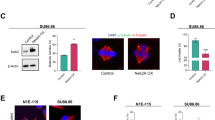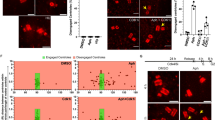Abstract
Centrosome amplification is a frequent phenomenon in malignancies and may facilitate tumorigenesis by promoting chromosomal instability. On the other hand, a centrosome inactivation checkpoint comprising centrosome amplification leading to elimination of cells by mitotic catastrophe has been described in response to DNA damage by ionizing radiation or cytostatic drugs. So far, the exact nature of DNA damage-induced centrosome amplification, which might be overduplication or fragmentation of existing centrosomes, has been controversial. To solve this controversy, we have established a method to distinguish between these two possibilities using A549 cells expressing photoconvertible CETN2-Dendra2. In response to various DNA-damaging treatments, centrosome amplification but not fragmentation was observed. Moreover, centrosome amplification was preceded by excessive formation of centrin-containing centriolar satellites, which were identified as de novo-generated atypical centrin dots staining positive for centriolar satellite markers but negative or only weakly positive for other established centrosomal markers, and which could be verified as centriolar satellites using immunogold electron microscopy. In line with this notion, disruption of dynein-mediated recruitment of centrosomal proteins via centriolar satellites suppressed centrosome amplification after DNA damage, and excessive formation of centriolar satellites could be inhibited by interference with Chk1, a known mediator of centrosome amplification in response to DNA damage. In conclusion, we provide a model in which a Chk1-mediated DNA damage checkpoint induces excessive formation of centriolar satellites constituting assembly platforms for centrosomal proteins, which subsequently leads to centrosome amplification.
This is a preview of subscription content, access via your institution
Access options
Subscribe to this journal
Receive 50 print issues and online access
$259.00 per year
only $5.18 per issue
Buy this article
- Purchase on SpringerLink
- Instant access to full article PDF
Prices may be subject to local taxes which are calculated during checkout







Similar content being viewed by others
References
Nigg EA, Raff JW . Centrioles, centrosomes, and cilia in health and disease. Cell 2009; 139: 663–678.
Doxsey S, Zimmerman W, Mikule K . Centrosome control of the cell cycle. Trends Cell Biol 2005; 15: 303–311.
Zyss D, Gergely F . Centrosome function in cancer: guilty or innocent? Trends Cell Biol 2009; 19: 334–346.
Löffler H, Lukas J, Bartek J, Krämer A . Structure meets function--centrosomes, genome maintenance and the DNA damage response. Exp Cell Res 2006; 312: 2633–2640.
Krämer A, Mailand N, Lukas C, Syljuåsen RG, Wilkinson CJ, Nigg EA et al. Centrosome-associated Chk1 prevents premature activation of cyclin-B-Cdk1 kinase. Nat Cell Biol 2004; 6: 884–891.
Krämer A, Lukas J, Bartek J . Checking out the centrosome. Cell Cycle 2004; 3: 1390–1393.
Bärenz F, Mayilo D, Gruss OJ . Centriolar satellites: busy orbits around the centrosome. Eur J Cell Biol 2011; 90: 983–989.
Kubo A, Sasaki H, Yuba-Kubo A, Tsukita S, Shiina N . Centriolar satellites: molecular characterization, ATP-dependent movement toward centrioles and possible involvement in ciliogenesis. J Cell Biol 1999; 147: 969–980.
Dammermann A, Merdes A . Assembly of centrosomal proteins and microtubule organization depends on PCM-1. J Cell Biol 2002; 159: 255–266.
Kubo A, Tsukita S . Non-membranous granular organelle consisting of PCM-1: subcellular distribution and cell-cycle-dependent assembly/disassembly. J Cell Sci 2003; 116 (Part 5): 919–928.
Lopes CA, Prosser SL, Romio L, Hirst RA, O'Callaghan C, Woolf AS et al. Centriolar satellites are assembly points for proteins implicated in human ciliopathies, including oral-facial-digital syndrome 1. J Cell Sci 2011; 124 (Part 4): 600–612.
Kodani A, Tonthat V, Wu B, Sutterlin C . Par6 alpha interacts with the dynactin subunit p150 Glued and is a critical regulator of centrosomal protein recruitment. Mol Biol Cell 2010; 21: 3376–3385.
Krämer A . Centrosome aberrations – hen or egg in cancer initiation and progression? Leukemia 2005; 19: 1142–1144.
Ganem NJ, Godinho SA, Pellman D . A mechanism linking extra centrosomes to chromosomal instability. Nature 2009; 460: 278–282.
Levis AG, Marin G . Induction of multipolar spindles by X-radiation in mammalian cells in vitro. Exp Cell Res 1963; 31: 448–451.
Fetner RH, Porter ED . Multipolar mitosis in the Kb (Eagle) human cell line and its increased frequency as a function of 250 Kv X-irradiation. Exp Cell Res 1965; 37: 429–439.
Sato C, Kuriyama R, Nishizawa K . Microtubule-organizing centers abnormal in number, structure, and nucleating activity in x-irradiated mammalian cells. J Cell Biol 1983; 96: 776–782.
Hut HM, Lemstra W, Blaauw EH, Van Cappellen GW, Kampinga HH, Sibon OC . Centrosomes split in the presence of impaired DNA integrity during mitosis. Mol Biol Cell 2003; 14: 1993–2004.
Yih LH, Tseng YY, Wu YC, Lee TC . Induction of centrosome amplification during arsenite-induced mitotic arrest in CGL-2 cells. Cancer Res 2006; 66: 2098–2106.
Takada S, Kelkar A, Theurkauf WE . Drosophila checkpoint kinase 2 couples centrosome function and spindle assembly to genomic integrity. Cell 2003; 113: 87–99.
Löffler H, Bochtler T, Fritz B, Tews B, Ho AD, Lukas J et al. DNA damage-induced accumulation of centrosomal Chk1 contributes to its checkpoint function. Cell Cycle 2007; 6: 2541–2548.
Bourke E, Dodson H, Merdes A, Cuffe L, Zachos G, Walker M et al. DNA damage induces Chk1-dependent centrosome amplification. EMBO Rep 2007; 8: 603–609.
Sibon OC, Kelkar A, Lemstra W, Theurkauf WE . DNA-replication/DNA-damage-dependent centrosome inactivation in Drosophila embryos. Nat Cell Biol 2000; 2: 90–95.
Bourke E, Brown JA, Takeda S, Hochegger H, Morrison CG . DNA damage induces Chk1-dependent threonine-160 phosphorylation and activation of Cdk2. Oncogene 2010; 29: 616–624.
Robinson HM, Black EJ, Brown R, Gillespie DA . DNA mismatch repair and Chk1-dependent centrosome amplification in response to DNA alkylation damage. Cell Cycle 2007; 6: 982–992.
White RA, Pan Z, Salisbury JL . GFP-centrin as a marker for centriole dynamics in living cells. Micros Res Techniq 2000; 49: 451–457.
Gurskaya NG, Verkhusha VV, Shcheglov AS, Staroverov DB, Chepurnykh TV, Fradkov AF et al. Engineering of a monomeric green-to-red photoactivatable fluorescent protein induced by blue light. Nat Biotechnol 2006; 24: 461–465.
Kobayashi T, Martensen T, Nath J, Flavin M . Inhibition of dynein ATPase by vanadate, and its possible use as a probe for the role of dynein in cytoplasmic motility. Biochem Biophys Res Commun 1978; 81: 1313–1318.
Zhao H, Watkins JL, Piwnica-Worms H . Disruption of the checkpoint kinase 1/cell division cycle 25A pathway abrogates ionizing radiation-induced S and G2 checkpoints. Proc Natl Acad Sci USA 2002; 99: 14795–14800.
Prosser SL, Straatman KR, Fry AM . Molecular dissection of the centrosome overduplication pathway in S-phase-arrested cells. Mol Cell Biol 2009; 29: 1760–1773.
Löffler H, Fechter A, Matuszewska M, Saffrich R, Mistrik M, Marhold J et al. Cep63 recruits Cdk1 to the centrosome: implications for regulation of mitotic entry, centrosome amplification, and genome maintenance. Cancer Res 2011; 71: 2129–2139.
Habedanck R, Stierhof YD, Wilkinson CJ, Nigg EA . The Polo kinase Plk4 functions in centriole duplication. Nat Cell Biol 2005; 7: 1140–1146.
Leidel S, Delattre M, Cerutti L, Baumer K, Gonczy P . SAS-6 defines a protein family required for centrosome duplication in C. elegans and in human cells. Nat Cell Biol 2005; 7: 115–125.
Boutros R, Lobjois V, Ducommun B . CDC25B involvement in the centrosome duplication cycle and in microtubule nucleation. Cancer Res 2007; 67: 11557–11564.
Stevens NR, Roque H, Raff JW . DSas-6 and Ana2 coassemble into tubules to promote centriole duplication and engagement. Developmental cell 2010; 19: 913–919.
Heilig CE, Löffler H, Mahlknecht U, Janssen JW, Ho AD, Jauch A et al. Chromosomal instability correlates with poor outcome in patients with myelodysplastic syndromes irrespectively of the cytogenetic risk group. J Cell Mol Med 2010; 14: 895–902.
Acknowledgements
We thank Birgit Hub and Sigrid Heil for excellent technical assistance, and Andrew M Fry, Andreas Merdes, Jeffrey L Salisbury and Richard B Vallee for important reagents. This work was supported by the Deutsche Krebshilfe (grant 108560).
Author information
Authors and Affiliations
Corresponding author
Ethics declarations
Competing interests
The authors declare no conflict of interest.
Additional information
Supplementary Information accompanies the paper on the Oncogene website
Supplementary information
Rights and permissions
About this article
Cite this article
Löffler, H., Fechter, A., Liu, F. et al. DNA damage-induced centrosome amplification occurs via excessive formation of centriolar satellites. Oncogene 32, 2963–2972 (2013). https://doi.org/10.1038/onc.2012.310
Received:
Revised:
Accepted:
Published:
Issue Date:
DOI: https://doi.org/10.1038/onc.2012.310



